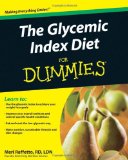|
The Glycemic Index Diet is based on the Glycemic Index (GI). According to the Glycemic Index Diet all foods can be eaten as long as they have a low Glycemic Index. It is not necessary to reducing the amount of calories and fat- consumption on the Glycemic Index Diet.
What is the Glycemic Index?
The Glycemic Index is a ranking system for carbohydrates based on their immediate effect on blood glucose levels.
The effect of foods with a high Glycemic Index
Carbohydrates with a high Glycemic Index are absorbed quickly by the body and cause the blood glucose levels to rise rapidly. The body then releases large amounts of insulin in order to decrease the high blood glucose level. The excessive amounts of insulin lower the blood glucose level to such an extent that it can cause a mild form of hypoglycaemia. The reaction that your body gives you as a result of this hypoglycaemia is a feeling of hunger. Furthermore the higher levels of insulin make the decomposition of fat more difficult.
The effect of foods with a low Glycemic Index
Carbohydrates with a low Glycemic Index are broken down slowly. This lower glycemic response equates to a lower insulin demand and a better long-term glucose control. This also means that the food fills you up for much longer.
top 

The Complete Idiot's Guide to Glycemic Index Weight Loss, 2nd Edition, Lucy Beale Lucy Beale, M.S., R.D., C.D.E., Joan Clark-Warner
|
Evaluation of the Glycemic Index Diet
- The Glycemic Index is helpful when choosing foods that are filling. It is practical for discovering the cause of cravings. It also useful in explaining why little sweet treats from the baker are not filling.
- The diet does not only consist of carbohydrates. Fat and protein must also be consumed in the diet. An example: Dark chocolate has a low Glycemic Index, i.e. the carbohydrates will be absorbed slowly by the body which fill you up for longer periods of time. It is debatable whether dark chocolate, with its high fat and calorie content, is suitable for weight loss.
- The level of energy and fat supply is irrelevant. This claim is not scientifically proven.
- In order to compare foods, it is necessary to compare portions of food with a comparable level of carbohydrates. The GI does not refer to the amount of food but to the amount of carbohydrates.
- The Glycemic Index varies from person to person. The GI is only valid for individual foods and not for food combinations such as bread with butter and marmalade or for meals with different nutrients. The problem therefore is that most food is eaten in some sort of combination which simply makes the Glycemic Index a theoretical reference.
top 

The Glycemic-Load Diet: A powerful new program for losing weight and reversing insulin resistance, Rob Thompson

The Glycemic Index Diet For Dummies, Meri Raffetto
|

